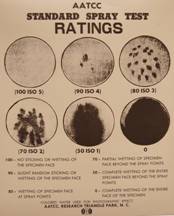Purpose of Test
The water repellency spray test evaluates a fabric’s resistance to getting wet with water. This test is primarily used for textile fabrics that may or may not have been treated with a water-repellent finish.
This test is ideal for assessing water resistance of various fabric finishes.
The test results for this method depend on the water repellency of the following materials used:
- Fibers
- Yarns
- Fabric construction
- Fabric finish
Terminology Defined
Water Resistance – The fabric’s resistance to water wetting and penetration.
Water Repellency – The fabric’s resistance to water wetting.
Visual Rating Scale – The visual chart containing the corresponding ratings for wetted patterns.

Test Method
Materials Used for Test
- Test specimen
- Visual rating scale
- Spray test apparatus

Testing Procedure
The test is performed by evaluating the water spray pattern on the test specimen’s surface under controlled conditions with the use of a visual rating scale.
Test Procedure (Summary)
Part 1: Water spraying: The test specimen is laid flat and stretched out on a surface. Water is sprayed onto the taut fabric under controlled conditions. The wetted pattern depends on the water repellency level of the test specimen.
Part 2: Evaluating water repellency: The water repellency level is evaluated by comparing the wetted pattern to the visual rating scale.